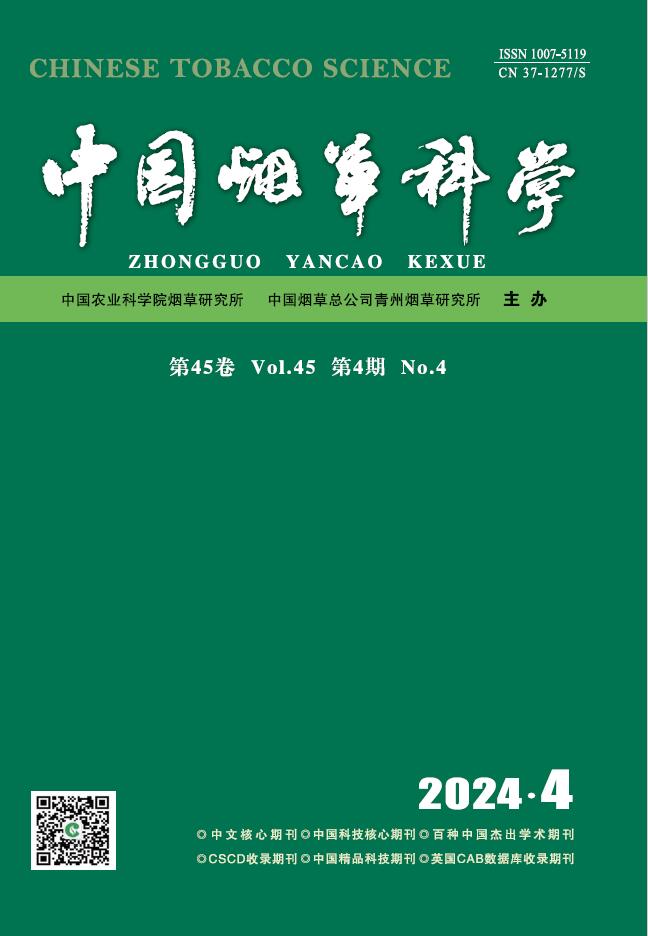白肋和烤烟品种对蓟马传播的番茄斑点枯萎病毒的易感性
引用次数: 0
摘要
番茄斑点枯萎病毒(TSWV)是一种具有重要经济意义的植物病毒,属于布尼亚病毒科和Tospovirus属,于20世纪80年代中后期在美国首次发现,1988年在北卡罗来纳州烟草中首次发现。到1997年,几乎在北卡罗莱纳州的每个县都发现了TSWV。自引入TSWV以来,TSWV发病率有所增加。感染TSWV的烟草植株表现出一系列症状,包括叶片萎黄、环状斑点、坏死病变、叶脉变色和发育迟缓。大多数感染了TSWV的烟草植株最终会死亡。TSWV通过7种蓟马在世界范围内进行机械传播。烟蓟马fusliniella (Hinds) (Thysanoptera: Thripidae)是北卡罗来纳州东部和中部最重要的TSWV病媒,西部花蓟马Frankliniella occidentalis (Pergande) (Thysanoptera: Thripidae)是该州西部山前和山区的重要地方病媒。Previo……本文章由计算机程序翻译,如有差异,请以英文原文为准。
SUSCEPTIBILITY OF BURLEY AND FLUE-CURED TOBACCO TYPES TO TOMATO SPOTTED WILT VIRUS TRANSMITTED BY THRIPS (ORDER: THYSANOPTERA)
Tomato spotted wilt virus (TSWV) is an economically important plant virus, belonging to the family Bunyaviridae and genus Tospovirus, first identified in the United States in the middle to late 1980s and in North Carolina tobacco in 1988. By 1997 TSWV had been identified in nearly every North Carolina county. TSWV incidence has increased since its introduction. Tobacco plants infected with TSWV display a range of symptoms, including wilting and yellowing of leaves, ring spots, necrotic lesions, discoloration of leaf veins, and stunting. The majority of tobacco plants infected with TSWV will eventually die. TSWV is transmitted mechanically by 7 thrips species worldwide. The tobacco thrips, Frankliniella fusca (Hinds) (Thysanoptera: Thripidae) is the most important vector of TSWV in eastern and central North Carolina, and the western flower thrips, Frankliniella occidentalis (Pergande) (Thysanoptera: Thripidae) is a locally important vector in the western piedmont and mountainous region of the state. Previo...
求助全文
通过发布文献求助,成功后即可免费获取论文全文。
去求助
来源期刊

中国烟草科学
烟草
自引率
0.00%
发文量
3722
期刊介绍:
Chinese Tobacco Science is an academic scientific journal (bimonthly) under the supervision of the Ministry of Agriculture and Rural Affairs of the People's Republic of China, and sponsored by the Tobacco Research Institute of the Chinese Academy of Agricultural Sciences and the Qingzhou Tobacco Research Institute of China National Tobacco Corporation. It was founded in 1979 and is publicly distributed nationwide. The journal mainly publishes academic papers on scientific research results, new production technologies, and modern management in my country's tobacco science research and tobacco production technology. In addition, it also publishes forward-looking review articles in the field of tobacco research. There are columns such as tobacco genetics and breeding, cultivation technology, modulation and processing, physiology and biochemistry, plant protection, review or monograph, quality chemistry, etc.
 求助内容:
求助内容: 应助结果提醒方式:
应助结果提醒方式:


